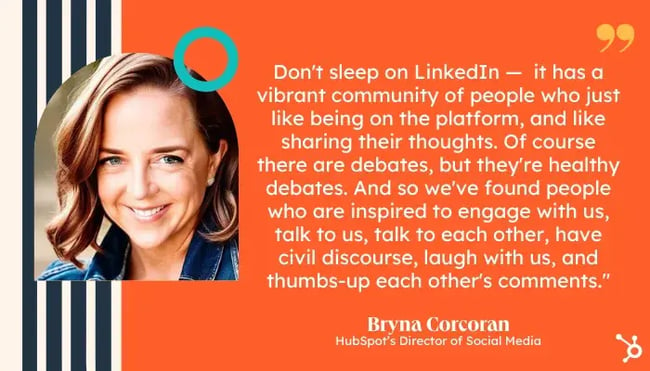Welcome to HubSpot's Expert Edge Series, where we interview top execs at major brands to explore their perspectives on the latest trends, challenges, and opportunities shaping the industry.
Over the past few months, you might‘ve noticed a shift in HubSpot’s social strategy.
The more traditional B2B posts have given way to a social media presence that is funnier, more casual, and definitely more meme-ified, which got me thinking: What's the reason behind the shift?
As HubSpot's Global Director of Social Media, Bryna Corcoran, told me: “… We started to speak to the next generation of marketing or sales reps … we started to use the Gen Z and millennial tone-of-voice. We started to dabble in internet culture; we started to post memes, which, you know, definitely got us some questionable faces. We started to make it more of a conversational community. And it's working.”
Turns out that it‘s more than just working. In only six months, HubSpot’s social team saw 84% year-over-year growth on LinkedIn, according to internal benchmarks.
Here, Corcoran shares with me her tips for growing a LinkedIn community and her broader insights on how to succeed across social platforms in 2025.
HubSpot's Director of Social On Creating A Strong LinkedIn Strategy, Becoming Relevant to Gen Z, and Experimenting Constantly
LinkedIn's audience has changed, so your content should, too.
When I sat down with Corcoran, the first question I asked her was simple: Why LinkedIn?
She told me there were several reasons. Some users have found it harder to thrive on X (previously known as Twitter), so they've gradually migrated to LinkedIn for that similar “open-forum town square” feel.
Additionally, more Gen Zs and younger millennials are now turning to LinkedIn for career development and job searching.
So the social team saw an opportunity: Why not test their Twitter tone-of-voice — short, text-only, casual posts, or what she calls “shower musings” — on LinkedIn?
And it blew up.
Corcoran says, “In the beginning, we were unsure how our new strategy would perform, so we treaded lightly by posting only a few times a week. But I'm happy to report that we're gaining followers faster than ever, and that's because we're taking a personal approach.”
She adds, “It's almost like we're turning HubSpot into a person, rather than a brand, by discussing the musings of how our customers are thinking or feeling on a daily basis as they try to grow their companies.”
LinkedIn‘s users expect to interact with businesses on the platform, so it’s a good platform to lean into.
There's another benefit to LinkedIn, too — while Instagram and Facebook are mainly for personal connections, users expect to interact with businesses on LinkedIn — that‘s the channel’s purpose.
In other words, businesses face fewer barriers on LinkedIn when engaging authentically with users.
As Corcoran told me, “Don't sleep on LinkedIn — It is one of the most credible platforms. To be on the platform, you need to put your real first and last name, and your work history is accurate. You're a reflection of the school you went to or the company you work for … so you're much more likely to contribute thoughtfully on LinkedIn compared to other platforms.”

She continues, “So what we've found on LinkedIn is a vibrant community of people who just like being on the platform and like sharing their thoughts. Of course, there are debates, but they're healthy debates. And so we've found people who are inspired to engage with us, talk to us, talk to each other, have civil discourse, laugh with us, and thumbs-up each other's comments.”
According to HubSpot's 2025 Global Social Media Trends Report, 84% of marketers agree that consumers are actively searching for brands on social media. LinkedIn remains a top B2B platform for engagement and brand discovery, and 23% of B2B marketers plan to increase their investments this year.
One other big plus and differentiation for LinkedIn? It can amplify your content to new audiences simply by engaging with the content. If Corcoran and I are connected as colleagues, but I don't follow HubSpot, and she comments on or likes a HubSpot post, LinkedIn will auto-publish that interaction and post it to my feed. LinkedIn provides incredible opportunities to broadcast your content to reach new prospects and leads simply through lightweight engagement.
Take an audience-first approach with any social strategy, while also leaning into cultural relevancy.
Roughly six months ago, Corcoran and her team decided to develop new, fresh personas for their social channels to enable them to take an audience-first approach. Now, when crafting a piece of social content, they can keep that person top of mind.
For instance, one persona they‘ve developed is the sales rep trying to get their cold calls answered. From there, it’s easier to brainstorm clever, relatable, text-based thoughts that could resonate with that persona and make them feel like HubSpot understands their challenges.
Corcoran told me she also looks at cultural moments. “We look at things that people are talking about outside of the HubSpot universe. What's top of mind for them? If we can connect to what's going on in culture, it's even stickier and more relatable.”
And that’s a smart move in 2025.
According to HubSpot’s Marketing Trends Report, marketers are doubling down on content that reflects brand values and taps into culturally relevant moments, especially with younger audiences in mind. Gen Z and Millennials are now the top target demographics for marketers, while attempts to reach Gen X and Boomers have dropped sharply.
Brands are also prioritizing content that feels real. Funny, relatable posts continue to drive the highest ROI — and 76% of marketers say authentic content consistently outperforms polished, highly produced assets.
In other words, aligning with culture and being yourself is a powerful, strategic move.
Corcoran adds, “In the beginning, there was a little bit of the ‘let's try everything' method because it was uncharted. So we decided to test a lot: Does our audience gravitate to a Barbie meme? Are we rubbing people the wrong way if we lean into grammatical errors because that's how Gen Z types?”
Now, before Corcoran's team posts anything, they ask themselves three questions:
- Who is this for?
- What's the HubSpot way in?
- How can we connect it to culture?
If they can strike those three things well, they typically find success. But, as Corcoran points out, they don‘t crush it every time — and they’re still learning.
You might be surprised by what types of content perform best with your audience, so testing is key.
When HubSpot recently won a G2 award, Corcoran’s team tested two approaches. They started by posting a traditional, official asset to highlight the win, and it quickly gained traction through shares.
Later that afternoon, they followed it up with a meme.
“That blew up,” Corcoran told me. “People were really energized by the fact that we had a little bit of swag with our G2 announcement. And the more fun, personality-driven approach accomplishes the same goal for us as the more corporate-looking post: Driving awareness.”
She adds, “If a post is too polished or clean on social, it gets misunderstood as an ad. So if we're doing a video, we take a TikTok or Reels approach where it's just 30 seconds shot on an iPhone and we put it out.”
That approach matches industry-wide data: In 2025, short-form videos and images will be the top content types driving ROI.
And instead of posting constantly, marketers are scaling back their cadence — nearly two-thirds say they don’t post daily, choosing to prioritize quality, timing, and tone over sheer volume.
If you work for a B2B company, it can be tempting to pigeonhole your brand on social media as polished, professional, and formal. But that doesn't necessarily have to be the case — the more you can personify your business, the easier it will be for decision-makers to connect with your brand.
Of course, what works best for one business will flop for another. So it‘s equally important to continue to test and iterate over time. For instance, at the end of each month, Corcoran and her team look at every post and say, ’Okay, how did this one perform? Was it short and easy to read? Was the graphic too corporate-y?'
As Corcoran told me, over time, you begin to notice themes. And those themes can help you better predict what performs well with your audience — and what doesn't.
I’ve learned from Corcoran that not every post will land perfectly, and that’s okay. The goal isn’t perfection; it’s consistent learning and iteration.
Pro tip: Corcoran recommends posting on LinkedIn three to four times weekly and avoiding weekends. As she put it: “We‘ve seen the most success posting first thing in the morning, around lunchtime, or around 5-6 PM — basically, when people are waking up, when they’re taking a lunch break, or when they're winding down after work.”
Shares mean your content connected emotionally with your audience.
Finally, I asked Corcoran how she measures success on social media. How does she know her team's social posts are driving business impact?
“We know a Miley Cyrus meme won't get you to purchase software, but we want you to be aware of HubSpot — that we‘re present, that we’re culturally relevant — so that we're top-of-mind when you are in the buying motion,” Corcoran told me.
She continues, “Our master goal is brand awareness and product consideration, and the way we measure brand awareness is through engagement: Whether that's liking, commenting, or sharing.”
She told me she gets especially excited when someone shares a post because it shows the content struck an emotional chord. It means the user paused, saw themselves in it, and felt moved to pass it along.
“Oftentimes, that person will share with someone who hasn't heard of HubSpot, and suddenly they're curious about us,” Corcoran said.
With social, be willing to test the boundaries.
Ultimately, if there‘s one thing I learned from Corcoran, it’s this: B2B businesses have historically played it safe when creating engaging content on social media.
But expectations are changing fast.
In 2025, the brands that win on social aren‘t just the loudest — they’re the most authentic, strategic, and audience-centered. As Corcoran‘s team continues to test and learn, they’re showing us what it looks like to grow a community by being brave, a little weird, and very real.
Talking to Corcoran reminded me that social success doesn’t come from having all the answers — it comes from showing up, testing, and not being afraid to sound human. That’s what makes people stop scrolling.
Editor's note: This post was originally published in April 2024 and has been updated for comprehensiveness.





Recent Comments